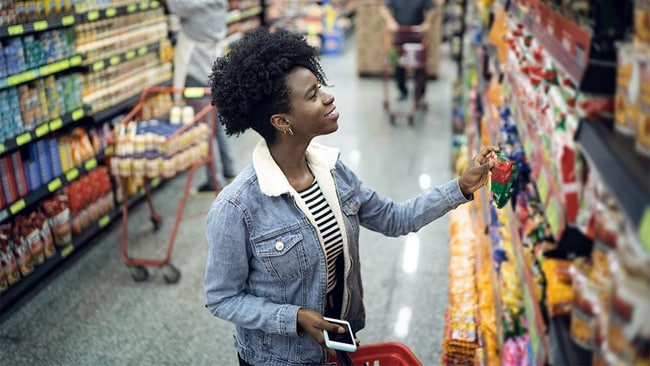The fast-moving consumer goods (FMCG) supply chain in Angola and the Democratic Republic of the Congo (DRC) is transitioning into a decisive growth phase. Urban expansion, rising disposable incomes, and stronger trade corridors are attracting global and regional players into these markets.
Although infrastructure challenges persist, both Angola and the DRC are attracting investments in cold chain development, logistics technology, and trade agreements, such as the African Continental Free Trade Area (AfCFTA).
For FMCG companies seeking scale in Sub-Saharan Africa, Angola’s market and evolving DRC logistics ecosystem are not just emerging. In the near future, they will become a key component of supply chain management.
Angola’s FMCG market: Supply chain shifts and opportunities
Angola’s consumer economy is undergoing rapid change. However, in order to understand where growth lies, a closer examination of both the market size and consumer spending patterns is required.
FMCG Market Value: Estimated at USD 10 to 13 billion and projected to grow, potentially reaching USD 15–20 billion.
Major Consumption Hubs: Luanda, Benguela, and Huíla are the biggest hubs for the FMCG sector with a growing demand for packaged foods, beverages, and hygiene products. While informal retail channels still dominate, the expansion of supermarkets, shopping malls, and digital platforms is changing shopping habits.
Seasonal Consumer Behavior:
- Independence Day, Christmas, and harvest festivals drive demand for packaged foods, frozen items, and household goods
- Back-to-school period sees an increase in demand for snacks and personal care products
The major challenges for FMCG supply chains in Angola with these surges are delays in restocking, cold chain gaps, and poor rural access, which remain as major challenges.
Strategic Local Developments influencing FMCG Supply Chain:
- Cold chain growth: New cold storage, solar-powered refrigeration, and reefer containers are strengthening perishables distribution.
- Digital delivery growth: Platforms like Tupuca and Appy Saúde are reshaping urban logistics with app-based ordering and delivery.
- Port and corridor modernization: Upgrades at Luanda and Lobito ports, and the U.S.-backed Lobito Corridor, are reinforcing Angola’s role as a trade gateway.
- Local manufacturing push: Incentives under the government’s diversification plan encourage “Made in Angola” goods, reducing reliance on imports.
Booming FMCG supply chain in the DRC
Same as Angola’s FMCG market, the DRC is experiencing rapid FMCG demand growth, though its scale and challenges present a different set of dynamics for supply chain players.
Market Value: Estimated at USD 12–15 billion and is projected to grow, with potential to reach USD 18–20 billion in the coming years.
Major Consumption Hubs: Kinshasa, Lubumbashi, and Goma, where supermarkets and e-commerce channels are steadily expanding.
Seasonal Consumer Behavior:
- Independence Day, Christmas, and religious holidays like Easter and Eid drive demand for food, beverages, and personal care
- Harvest periods boost rural incomes and spending on staples
- Back-to-school periods increase spending on snacks and hygiene products
However, these peaks expose vulnerabilities in DRC logistics, especially congestion at Matadi and Boma ports.
Strategic Local Developments influencing FMCG Supply Chain:
- Cold chain growth: Investments in Kinshasa and Lubumbashi are addressing critical refrigeration gaps.
- Digital logistics platforms: Startups such as Wapiyo are improving inventory visibility and supporting e-commerce fulfillment.
- Formal retail investments: Chains like City Market and Shoprite are strengthening formal retail channels.
- Infrastructure upgrades: The Kasumbalesa border project and the new Banana Port are designed to ease trade bottlenecks and expand regional flows.
Key drivers behind FMCG supply chain growth in Angola and the DRC
While each country has unique traits, several common factors are influencing FMCG supply chain growth across both Angola and DRC.
Cold chain growth
Both Angola and the DRC are investing in cold chain logistics infrastructure such as reefer containers, storage facilities, and renewable-powered refrigeration. Enhancing the cold chain capabilities in the region is essential to reduce spoilage and ensure the consistent availability of perishable goods. Thus, these investments also enable FMCG supply chain growth in Angola and DRC.
Digital logistics and e-commerce
Mobile-first delivery apps are reshaping the distribution of goods, especially in urban areas, by providing improved visibility and efficiency. Customers expect clarity, convenience and speed when they order FMCG products, thereby increasing the need for digital equality in logistics. Digital tools provide real-time tracking of orders, seamless payment and return experience, and information on flash sales/offers for customers. Whereas for FMCG companies, it helps to centralise all their data and improve inventory management, monitor temperature controls, ensure transparency and traceability in all transactions and also shorten delivery windows with route optimisation. Digital platforms are increasing the resilience and growth of FMCG supply chains in Angola and the DRC.
Trade corridors and port modernization
There is a deep focus on the modernization of Lobito, Luanda, Matadi, and Banana ports. Additionally, trade agreements like the AfCFTA are also driving reforms in Customs to ease the import and exports of goods. The combination of these developments is resulting in the expansion of regional connectivity and shortening clearance times. This in turn boosts FMCG supply chain growth in Angola and DRC.
Regional integration
Through AfCFTA, SADC, and COMESA membership, both Angola and the DRC are reforming and aligning regulations and reducing tariffs. These policies are creating a more predictable and favourable environment for FMCG cross-border trade.
Policy, investment, and building resilient supply chains
Beyond infrastructure, government initiatives and business strategies are playing a crucial role in the growth of FMCG supply chains.
Local production and incentives
Both governments are encouraging domestic production of goods and materials through tax incentives, procurement policies, and financing support. By sourcing locally, FMCG companies reduce their dependency on imports and strengthen resilience in their supply chains.
Customs and trade facilitation
Digital customs systems and one-stop border posts are reducing bottlenecks at key crossings. Customs processes are being digitized in Angola, while border points such as Kasumbalesa and Mahagi are being upgraded in the DRC.
Resilience and risk planning
Flood-proof warehouses, hybrid energy systems, and decentralized storage hubs are being developed to counter risks from unreliable utilities and extreme weather. These measures are creating a more robust FMCG supply chain in Angola and the DRC with the potential for improved growth and efficiency.
Angola vs. DRC: Comparing FMCG supply chain opportunities
Compared to Angola's FMCG market, the DRC offers scale unmatched elsewhere in the region. While Angola provides relatively easier entry points for FMCG exporters, the DRC rewards long-term strategies that can adapt FMCG supply chains to infrastructure and regulatory hurdles.
For distributors, Angola’s strength for the FMCG sector lies in its integration with the Lobito Corridor and growing port capacity. The DRC, on the other hand, offers FMCG companies with an enormous domestic consumer pool but requires patience and flexible strategies to navigate inconsistent regulations and transport challenges.
Global FMCG brands evaluating these markets should weigh speed versus scale. Angola provides immediate regional logistics advantages. Meanwhile, the DRC offers long-term rewards for those willing to invest in logistics networks and local production partnerships.
What's next for FMCG supply chains in Angola and Congo?
The Central West Africa region stands at a defining moment. FMCG supply chains in Angola and the DRC are on the verge of significant transformation, driven by infrastructure upgrades, digital innovation, local production, and regional integration.
Buoyed by local production and trade corridors, Angola’s FMCG market is strengthening. At the same time, DRC logistics are evolving with port upgrades and digital delivery. With both countries strengthening cold chain growth to guarantee year-round availability of perishable goods, the region is entering a decisive phase for supply chain investment. The coming years will favor companies that invest early and build resilience, as these markets become increasingly central to Africa’s consumer goods landscape.
Be ready to seize this momentum and explore how you can secure the resilience, reach, and reliability your supply chain needs across Angola and the DRC. For more details on our FMCG solutions, get started here.
Discover more useful articles with Maersk Logistics Insights and learn more about other relevant insights on supply chain growth as well as on the FMCG sector. Or for more logistics trends and insights, read and download The Logistics Trend Map.















